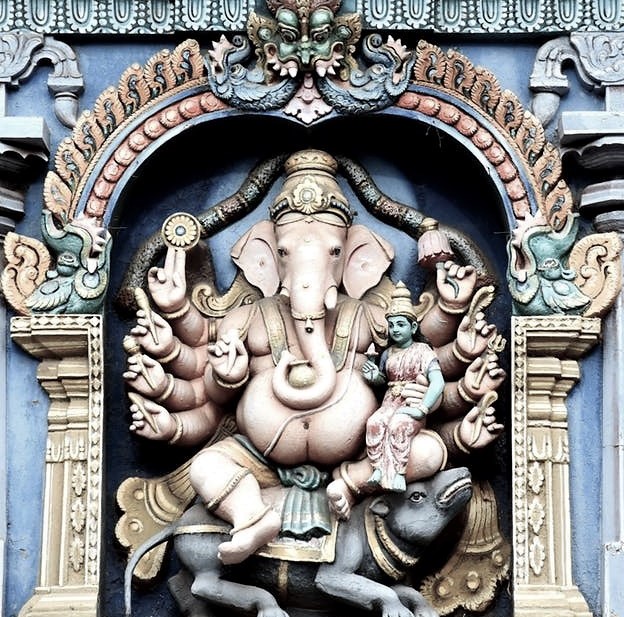- Special FeaturesFoundation YearThe temple was built during 685-705AD 7th centurySthala TreeTheerthamRathamArchitecturePallava architectureOther Speciality
- Sthala Puran
Kailasanathar Temple is one of the oldest temples of Kanchipuram. Built in 7th century, this temple is known for beautiful architecture. Surrounded with beautiful curvatures, pillared halls and vestibules, pyramidal towers and frescos, this is one of the well maintained temples of Pallava dynasty.
Dedicated to Lord Shiva this temple was built by the Pallava rulers. Its construction began during the reign of Narsimha Varmana II who is also known as Raja Simha but was completed during the reign of his son Mahendravarma III.
Kailasanatha Temple, also known as Kailasanathar Kovil, displays a unique architecture. It has its main sanctum facing the east side. The rear wall of the temple has a sculpture of Somaskanda (Lord Siva and Uma with son Muruga in the centre), which was always seen in Shiva temples of the Pallava age.
There is a large sixteen-sided 'Shiva linga' in the temple shrine here. This linga is about eight feet in height. In the temple there is a small passage which begins from the entrance of the garbhagriha and around the shivalinga. It starts from the right side and ends on the left side of the lingam.
According to the priests of the temple ,the narrow passage was built deliberately in which the devotees have to crawl and begin their rotation from the right and finish on the left side of the lingam.
The process of crawling signifies that man crawls in his initial stage and learns to grow slowly and gradually while he again has to crawl in his later stage. In this way Lord Shiva ensures that there is no punarjanma, if one is successful in completing the rotation.
The Kailasanatha temple has many attractive sculptures, which portrays the different manifestations of Lord Siva like Dakshinamurti, Lingodhbhavamurti, Gajasamharamurti and many others. These sculptures also depict Siva in various dance poses that speak of the skill and deftness of the Pallava sculptors and master craftsmen.
The temple is also known for the fine pillars which surround the mandapa of the temple. The temple has numerous pillars and panels which are rich in ancient sculptures. They contain the structures of lion and figures of Hindu gods and goddesses along with beautiful structure of Nataraja. This makes it one of the thoroughly decorated temples of Kanchipuram that depicts pallava style of architecture.
There is a 'Somaskanda' panel in the temple, which is said to be the original image worshipped here. There is a lingam on the rear wall, which belonged to a later age. The row of fifty-eight miniature shrines on all four sides of the courtyard of this temple-complex facing the main temple is very remarkable feature of the temple.
All these shrines here are of square shaped and are of sandstone. There are very gorgeous sculptures found inside the inner wall and on some of them the 'Somaskanda panel' can be found. There is a small gopuram at the entrance of the temple.
On each face of the outer walls of the main shrine there are many carvings of gods and goddesses. In the south facing wall the sculpture depicts Shiva as Umamaheshavara with Varaha, flanked by Brahma and Vishnu and flying amaras at the lower level.
The west facing hall has sculptures of Shiva in the form of Sandhya Tandavamurti and Urdhava Tandvamurti and the ensemble is complete with images of ganas in dancing poses and also with images of Brahma, Vishnu, Nandi and Parvathi.
The carving of Shiva on the north facing wall is a composition of Tripurantaka flanked by three ganas, goddess Durga with three ganas, and Bhairavi, Kaushiki and Jyestha.
The exterior faces of the vimana (tower) have images of Bhikshatana, Somaskanda and Shiva in Samhara-Tandava (destructive dancing) pose.
Thus with its well known sculptures and architecture it is considered as one of the oldest temples of South India.
The temple is maintained by Archaeological Survey of India.
- Architecture
- Alankar of Deity
- Prayers and BenefitsSpecial Vratas and PrayersOfferings to DeityStotras and Mantras
- FestivalsMaha Shivaratri is the biggest festival
- Sodasha Upcharas
- Prasadhas
- Social ActivitiesAnnadhanMarriageEar BoringHead ShaveDanaasEducation FacilitiesSocial DrivesOther Activities
- Arjita Seva
- Tags

